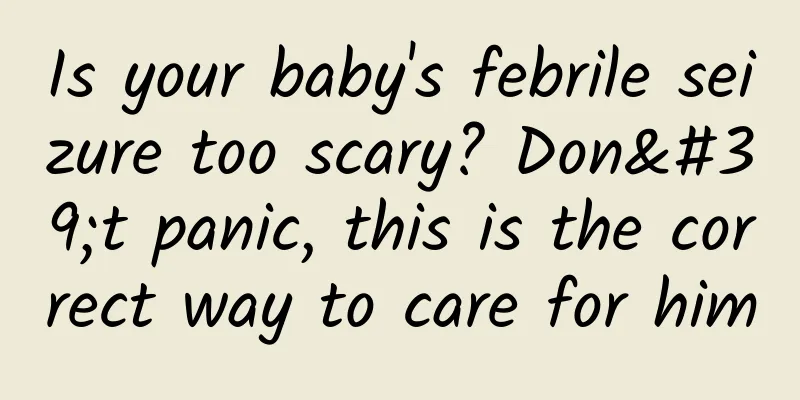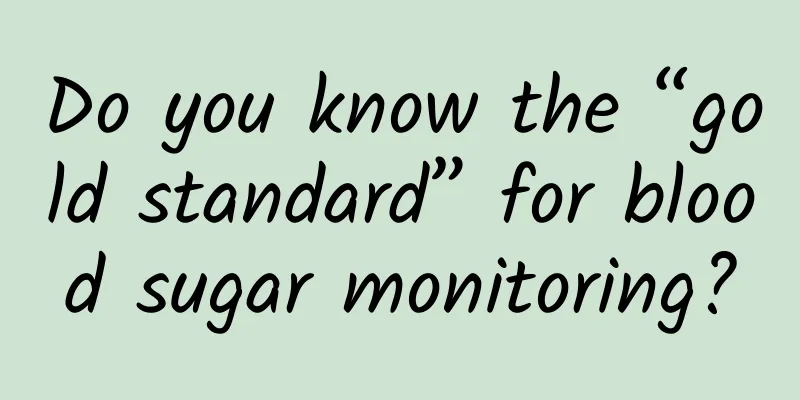Is your baby's febrile seizure too scary? Don't panic, this is the correct way to care for him

|
Mothers usually feel anxious because of the little problems of their babies, especially when their babies have febrile convulsions. But mothers, don't worry, let's learn about the correct care methods! With these, you can face your baby's febrile convulsions more calmly and protect their healthy growth. 1. What is a febrile seizure? Convulsions are sudden abnormal discharges of brain cells caused by abnormal neuronal function, resulting in involuntary contraction of whole or local muscles, usually accompanied by impaired consciousness. This symptom is often caused by other underlying diseases. According to statistics, about 4% of children under the age of 15 have experienced at least one seizure, and nearly half of them are febrile seizures caused by fever. Febrile seizures refer to seizures that occur in children aged 3 months to 5 years at the beginning of fever or when the body temperature rises rapidly, excluding other causes of seizures such as intracranial infection, and the patient has no history of afebrile seizures before. Febrile seizures can be divided into simple and complex types, mainly occurring in children aged 6 months to 5 years, with the peak age of onset being about 18 months. In children of this age group, the incidence of febrile seizures is about 2% to 5%, accounting for about 30% of all kinds of childhood seizures. Most febrile seizures are short-lived and self-limiting, but if the seizure lasts for more than 10 minutes, it needs to be sent to the emergency department for treatment immediately. 2. What are the symptoms of febrile convulsions? Febrile seizures are a neurological reaction in infants and young children when their body temperature rises sharply. The manifestations vary. Understanding these manifestations is crucial for parents to respond in time and provide help. The following are some common manifestations of febrile seizures: 1. Convulsions: These are usually systemic, but may sometimes involve only part of the body. The severity and duration of the convulsions can vary, from minor muscle twitches to full-body spasms. 2. Rigidity: In cases of rigidity, the child's muscles tense and the body becomes stiff. This may occur with convulsions or as an independent symptom. Parents should pay attention and take timely measures to protect their children from harm. 3. Eyes rolling up (nystagmus): During a febrile seizure, a child's eyes may roll upward, which is called nystagmus. This may occur at the same time as the convulsion or it may be a separate symptom. Nystagmus is usually temporary, but parents should pay close attention and consult a doctor in time. 4. Foaming at the mouth: Another common manifestation of febrile seizures is foaming at the mouth. This is caused by the involuntary contraction of the oral muscles during the child's convulsion, which leads to increased saliva secretion. Although foaming at the mouth itself is usually not dangerous to children, parents should ensure that children are in a safe environment and pay attention to protecting their breathing. 3. Pathogenesis and etiology of febrile seizures The development of the cerebral cortex of children is not yet fully mature, which is manifested by more prominent excitatory activities and relatively insufficient analytical, discriminating and inhibitory functions. In addition, the myelin sheath of the axons of nerve fibers has not yet been fully formed, and its insulation and protection functions are not perfect. Therefore, even a relatively mild stimulus may form a strong excitation focus in the cerebral cortex, causing sudden abnormal discharges of nerve cells, which quickly spread and cause convulsions. This is the pathogenesis of febrile convulsions in children, and there are many common causes, as follows: 1. Infectious factors Intracranial infection: This type of infectious disease mainly includes meningitis, encephalitis and brain abscess caused by various pathogens. Meningitis refers to inflammation of the meninges caused by bacterial, viral, protozoan or fungal infection, which often leads to severe neurological symptoms, including convulsions. Brain abscess is a localized purulent lesion in brain tissue caused by bacterial infection, which can also cause convulsions. Extracranial infection: This includes various systemic infectious diseases, such as febrile seizures, toxic encephalopathy, tetanus, and Reye's syndrome. Febrile seizures are a common type of seizure that occurs when children have a fever, especially in the early stages of a fever or when the body temperature rises rapidly. 2. Non-infectious factors Intracranial diseases: These diseases include neonatal asphyxia, hypoxic-ischemic encephalopathy, epilepsy, cranial malformations, intracranial space-occupying lesions, neurogenetic diseases, and autoimmune encephalopathy, etc. Among them, epilepsy is a common neurological disease, and its onset may be accompanied by convulsions. Extracranial (systemic) disease: This includes acute poisoning, metabolic disorders, heart disease, and kidney disease. For example, certain acute poisonings such as lead poisoning or sedative overdose may also cause seizures. 4. Correct nursing methods for febrile convulsions 1. Stay calm: When your baby has a febrile seizure, parents should first stay calm. Although it can be scary and anxious to see your baby convulsing, parents must do their best to stay calm, as excessive anxiety may make the situation worse. A calm attitude helps parents respond effectively to emergencies and ensure that care measures are taken correctly. 2. Ensure safety: Parents need to quickly place the baby in a safe place and ensure that there are no dangerous objects in the surrounding environment, such as sharp objects, glass, etc., to prevent the baby from being injured during convulsions. If possible, place the baby on a soft and flat ground or bed to reduce the risk of injury. 3. Lower body temperature: Parents can wipe the baby's body with warm water, especially the armpits, abdomen and inner thighs to help lower the body temperature. Avoid using too cold water to avoid causing a chill reaction. In addition, you can give your baby some warm water to keep their body hydrated. 4. Medical treatment and consultation: After the baby's condition stabilizes, parents should seek medical treatment in time. The doctor can help parents assess the baby's health and rule out other potential health problems. In addition, parents can also consult the doctor on how to prevent and deal with febrile seizures, as well as precautions for daily care. 5. How to prevent febrile seizures 1. Reasonably adjust the ambient temperature: In hot weather, parents should ensure that the room is well ventilated and consider using air conditioners or fans to lower the indoor temperature. In addition, avoid exposing the baby to high temperatures for a long time, such as directly exposed to the sun or in a closed car. 2. Take the temperature regularly: Regularly measuring the baby's temperature is one of the important steps to prevent febrile convulsions. Parents should regularly monitor the baby's temperature changes and take timely cooling measures when the temperature rises to avoid a sharp rise in temperature. 3. Keep your baby hydrated: Your baby’s water intake is very important for preventing febrile seizures. Parents should encourage their baby to drink plenty of water, especially in hot weather or when they have a fever, and pay attention to replenishing water in time to maintain the body’s water balance. Conclusion When a baby has a febrile seizure, it is understandable that parents are anxious, but remember that staying calm and providing proper care is the most important thing. By understanding the relevant knowledge about febrile seizures, learning the correct care methods, and preventive measures, parents can face their baby's febrile seizures more calmly and protect their healthy growth. At the same time, it is recommended that parents regularly participate in relevant parenting training courses to improve their care level and provide a better growth environment and care conditions for their babies. Let us work together to ensure that every baby can grow up healthily and happily! Author: Gao Xiaoxue Department of Pediatrics, Huizhou First People's Hospital |
<<: These 4 types of hepatitis B patients have a great chance of being “clinically cured”!
>>: The causes and daily prevention of hypertension keep you away from the "silent killer"
Recommend
I thought it was a cold, but it was actually a respiratory allergy! Can you tell the difference between these symptoms?
The weather has been really bad lately. Single di...
Is wakame seafood? How to make delicious wakame soup
In recent issues, we have been sharing a delicacy...
Why is the urine of pregnant women yellow?
Pregnant women will become very worried if their ...
What to do if there is brown discharge from vaginal discharge
Leucorrhea is something that all female compatrio...
The dangers of breastfeeding after taking a chest X-ray
Many women think that they should not take chest ...
Why is the discharge pink after sex?
After having sex, women have pink secretions, whi...
Which cancers are related to “eating”?
Pay attention, pay attention! The following 8 typ...
Can I do Pilates while I am menstruating?
Many women are too fat, so in this case, many peo...
How to treat fire in pregnant women
Many women eat a lot of warm and nourishing food ...
What to eat to enlarge breasts and lose weight
Many female friends are particularly concerned ab...
Can pregnant women eat pork?
It is well known that expectant mothers should pa...
Four-dimensional color ultrasound shows the boy's face
In the late stages of pregnancy when the fetus ha...
Nine golden points for women to maintain their health throughout their lives
Health maintenance is a lifelong task for women, ...
Pregnancy belly changes
The belly will continue to grow during pregnancy,...









